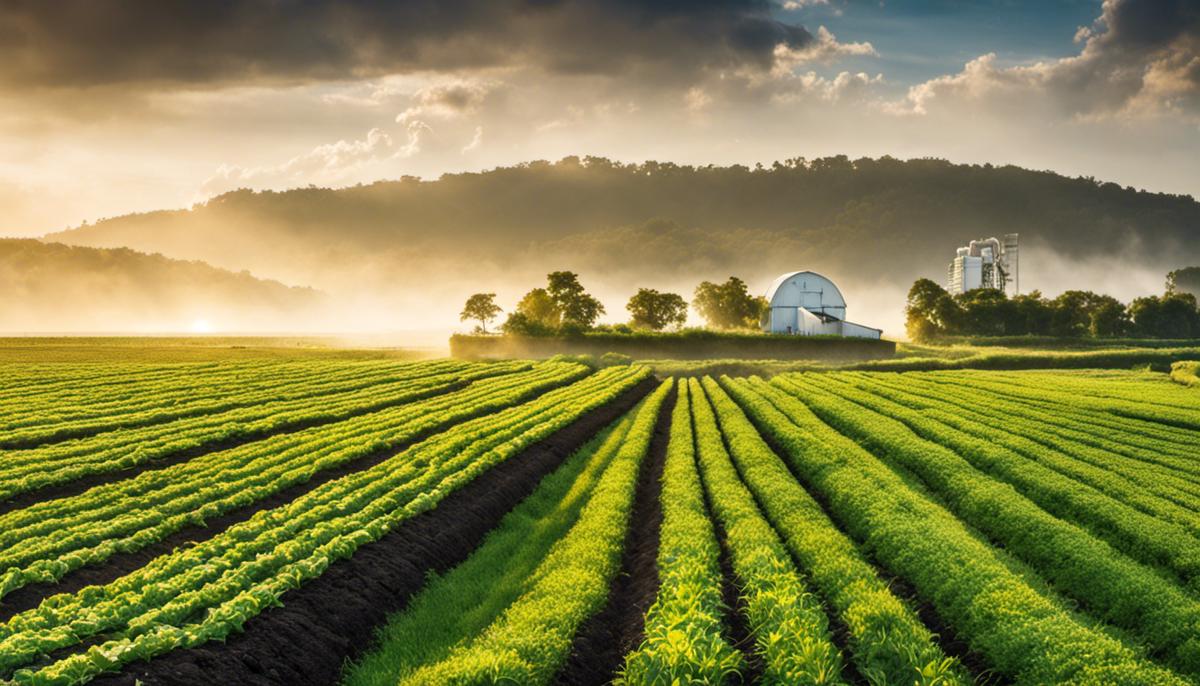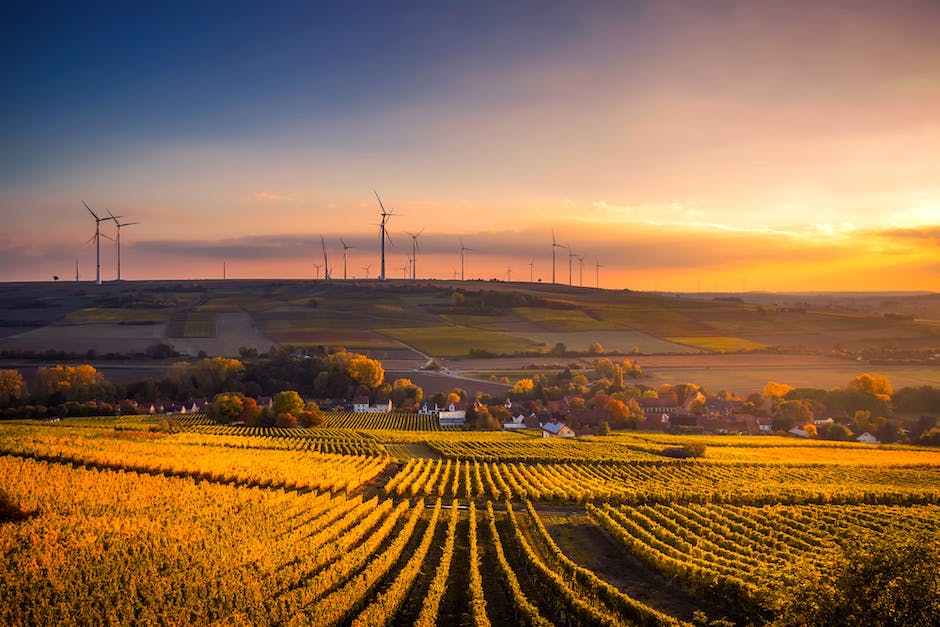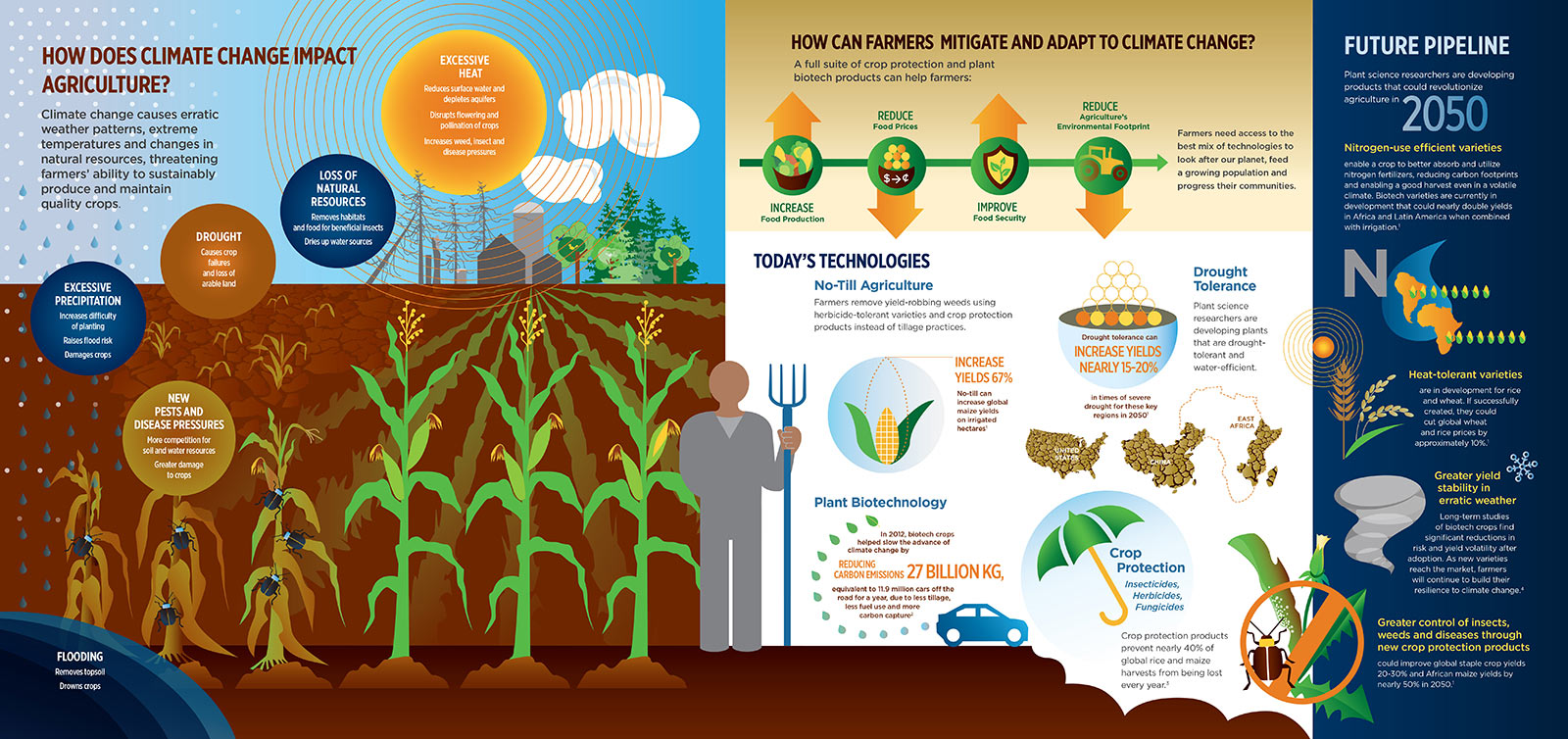
agricultures effect on climate change
Description: Climate change and agriculture hold a complex, reciprocal relationship that cuts across various aspects of human life and our planet's wellbeing. In essence, agriculture contributes significantly to the greenhouse gas emissions driving climate change, while concurrently, climatic changes profoundly affect agricultural productivity. This essay aims to explore these multidimensional interactions, explicating the how farming practices from livestock production, rice cultivation, and fertilizer usage to name a few, lead to substantial emissions of greenhouse gases such as methane and nitrous oxide. Furthermore, it delves into the repercussions of shifting precipitation patterns, elevated temperatures, and frequent extreme weather scenarios on global agriculture. Lastly, we'll delve into the implementation of climate-smart agriculture, an innovative approach aimed at making our farming systems more resilient to climate change, and explore the various policy measures and adaptive strategies employed to mitigate the impacts. The intricate intertwining of agricultural activities and greenhouse gas emissions is a subject worthy of simultaneous intrigue and scrutiny. As stewards of the natural world, it is incumbent upon the scientific community to reveal and comprehend the intense effects of farming on climate change. This article presents an analysis of the major ways farming contributes to this global issue. Agricultural practices are integral to the human way of life. Yet, they also contribute significantly towards the overall global greenhouse gas production. According to the Intergovernmental Panel on Climate Change (IPCC), agriculture accounted for 10-12% of total global anthropogenic greenhouse gas emissions in 2010. Unveiling the mechanisms through which agriculture imparts this substantial influence becomes a matter of crucial investigation. The primary agricultural activities that contribute to these emissions include: Livestock agriculture is a significant contributor, with its emissions stemming largely from enteric fermentation and manure. Ruminants such as cattle, sheep, and goats release methane, a potent greenhouse gas, as a byproduct of their digestion. Manure, when stored under anaerobic conditions, also produces methane. Livestock-based agriculture reportedly generated 39% of the total agricultural greenhouse gas outputs in 2011, a tangible demonstration of its impact. The cultivation of rice paddies, an integral part of the global food supply, similarly contributes to methane emissions. Flooded rice fields facilitate the growth of methanogens, microbial life forms that produce methane. This process, anaerobic fermentation, is responsible for 10% of total agricultural greenhouse gas emissions. The use of synthetic fertilizers, with their high nitrogen content, result in nitrous oxide emissions, a greenhouse gas nearly 300 times more potent than carbon dioxide over a 100-year period. Nitrous oxide emissions contribute 12% of total agricultural greenhouse emissions, representing the hidden cost of high-yielding crop variety cultivation. Manure when applied to soils, ploughed under crops, or simply left on the grazing land also contributes to nitrous oxide emission; not to mention the emissions resulting from manure transport. Deforestation for agricultural expansion is yet another indirect contributor. By removing carbon-absorbing trees to create space for fields and pastures, the global carbon budget is significantly impacted. Forest conversion to agricultural uses represents an enormous, often overlooked, global carbon dioxide source. It is evident that the relationship between agricultural activities and greenhouse gases is densely entangled and requires cautious untangling. This makes it incumbent upon humans to modify agricultural practices. Embracing sustainable farming, reducing dependency on synthetic fertilizers, more efficient livestock management, and limiting deforestation for farmland expansion, may hold the key to mitigating a substantial portion of these emissions. Deciphering these mysteries remains at the forefront of this tireless endeavour into creating a sustainable future for all life on planet Earth. As the climate changes, so do the fundamental parameters of global agricultural production. To cast light on the scope of this issue, it's beneficial to dissect the critical interactions between climate change and several key aspects of agricultural output—crop yield, pest proliferation, water availability, and soil fertility. The essential food crops—wheat, rice, maize, and soybeans—reliant on specific temperature and rainfall patterns, are experiencing drastic fluctuations in yield. Rising temperatures and atmospheric carbon dioxide concentrations, as noted in various research studies, can lower crop yields because heat stress disrupts the photosynthesis process, thereby reducing nutritive content. Yet, as we delve deeper, it isn’t merely the alteration of weather patterns that is driving this agricultural shift. A warmer environment beckons a significant increase in pests, diseases, and invasive species traditionally confined to tropical climates, further threatening crop yields. A relevant illustration refers to the ethological changes of pests. Warmer temperatures accelerate insect metabolism, increasing their rate of reproduction and subsequent crop damage, thus challenging food security. Water, the lifeblood of agriculture, is also at the heart of this intricately connected system. Droughts and shifts in precipitation patterns restrict the availability of this vital resource. Research indicates that the odds of water deficit years are heightening in already water-stressed regions. Strikingly, this can lead to reduced crop productivity and diminished groundwater stores for irrigation, generating a labyrinth of issues that bustle well beyond the confines of agriculture alone. Turning our gaze to soil, the underfoot unsung provider of sustenance, climate change instigates a decline in soil fertility. Changing precipitation patterns can cause erosion, leading to the loss of topsoil abundant in nutrients essential for plant growth. Additionally, warmer temperatures accelerate the decomposition of organic matter, compromising the soil's ability to store nutrients and secure plant roots effectively. Notably, soils are significant carbon sinks, and any disruption to their integrity further exacerbates greenhouse gas emissions—making it a twofold problem. Interlinking these findings, it is evident that climate change creates a compounded effect that hinges on each agricultural sector, engendering a series of domino effects. Harnessing the power of adaptive strategies, such as enhanced pest management, efficient irrigation technologies, and soil conservation practices, can somewhat buffer these impacts. It must be accentuated, nonetheless, that adaptations are not antidotes—they can moderate, but not entirely alleviate, the far-reaching impacts of climate change on global agricultural production. To sustain the human populace, a concerted effort must be directed towards reconfiguring agricultural practices in harmony with an evolving climate. Taking these challenges into account, it is increasingly evident that understanding and mitigating the impacts of climate change on agriculture is not a solitary endeavor. It is a global task requiring transdisciplinary collaboration and the marriage of science with policy and practice. Only in this coordinated effort can we ensure a viable agricultural future amid climate uncertainty. Continuing with the pressing topic of climate-smart agriculture, the objective is to delve deeper into the technologies and strategies employed to balance the intricate and complex web of emissions, yields, and challenges posed by climate change. Understanding these strategies and technologies can provide insightful perspectives into how agriculture can not only adapt to climate change but also contribute to mitigating its impacts. One of the grand strategies in climate-smart agriculture involves resource-conserving technologies that foster the principle of doing more with less. Precision agriculture is a case in point. Precision agriculture uses advanced technology and data, such as GPS and remote sensing, to supervise and manage crop production in a detailed and measured manner. This informed and targeted approach optimizes the use of water, seed, and fertilizers, reducing wastage and emissions while ensuring enhanced yield. Next, there is the strategy of promoting agroecological practices. This approach emphasizes regenerating and maintaining the ecological balances of agricultural systems. Examples of agroecological practices include agroforestry, where trees are integrated into farmlands to bolster biodiversity, soil health, and carbon sequestration. The practice of cover cropping, sowing crops to provide soil cover, also helps reduce soil degradation, which contributes significantly to the release of carbon dioxide. Then we have the impressive innovative frontiers of vertical farming and hydroponics. These game-changing technologies use less land and water by growing crops in vertically stacked layers or in nutrient-enriched water, respectively. They reduce the need for deforestation and significantly mitigate water and land resource pressures. Finally, digital agriculture incorporates artificial intelligence, machine learning, and big data to help farmers make precise and predictive decisions. Weather forecasting, disease and pest monitoring, and crop performance prediction can all be markedly improved with digital agriculture, boosting yield and resource-efficiency to combat climate change impacts. Yet, there is a critical underpinning to all these strategies and technologies: knowledge dissemination and stakeholder collaboration. Without information reaching the right people and organizations working in concert, these sophisticated solutions will remain unutilized. Thus, extension services, institutional coordination, supportive policies, and farmer training are vital multipliers in the climate-smart agriculture equation. In conclusion, it can be stated that the production of food is an intricate dance with nature and climate. It is in understanding the rhythm of this dance that the strategies and technologies of climate-smart agriculture can be choreographed. The curtain has been pulled back on a complex, yet exciting frontier that blends science, tradition, innovation, and crucially, the resolve of our societies. The task at hand is daunting, but the potential for transformation is profoundly inspiring. To contend with the accelerated changes in climate and their impacts on agriculture, the introduction and implementation of resource-conserving technologies, and specifically precision agriculture, have become increasingly prominent. Acknowledged for its capacity to optimize inputs and enhance efficiency, precision agriculture leverages advanced technologies such as global positioning systems (GPS) and remote sensing to obtain field level information. This information subsequently assists in creating site-specific treatment plans echoing the principle of 'Right Source, Right Rate, Right Time, Right Place'. In its stride towards climate-smart agriculture, the espousal of agroecological practices has also taken center stage. Practices such as agroforestry and cover cropping possess the potential to augment carbon sequestration, enrich soil health, improve water conservation, while also enhancing agricultural productivity. Agroforestry, in particular, has presented multi-functional benefits by integrating trees into agricultural landscapes, thereby fostering bio-diversity, raising productive capacity, and harmonizing the carbon and water cycles. In conjunction with traditional on-ground farming techniques, innovative farming strategies, including vertical farming and hydroponics, constitute pivotal responses against climate change. Vertical farming allows for the year-round growth of crops in an indoor, controlled environment, thus significantly reducing land use, water, and fertilizer requirements. Hydroponics, by contrast, involves growing plants in nutrient-rich water rather than soil, offering similar benefits by minimizing inputs and maximizing production output. As part of a modern agricultural framework, digital agriculture also showcases promising advancements. Through deploying artificial intelligence, machine learning, and big data analytics, digital agriculture paves the way for predictive analyses, automated farming equipment, yield optimization, and therefore, a resilient food system. However, recognizing the additional need to translate these techniques into practical actions, knowledge dissemination, stakeholder collaboration, and farmer training stand as vital enablers of such transition. Extension services, aiming to enhance farmers' adaptive capacity through technical guidance and capacity building, are a recognized conduit of knowledge in this realm. Critical, too, are institutional coordination and supportive policies, adept at fostering the synergy required between various stakeholders, and mitigating any unanticipated challenges that may arise. In conclusion, with climate change posing a formidable challenge to the global agricultural sector, it becomes indispensable to integrate both mitigation and adaptation strategies within agricultural practices. While the enlisted approaches yield significant potential, it is crucial to ensure their context specificity, ensuring all interventions harmonize with the local ecological, socio-cultural, and economic contexts. In a swiftly evolving global landscape, only such a comprehensive and malleable approach can ensure the continuing feasibility of agriculture. Understanding the interplay between agriculture and climate change provides vital insights that can guide us towards a more sustainable future. Agriculture, as a consistent contributor to greenhouse gases and hence climate change, necessitates an evolution towards practices that are not only resilient under changing climatic conditions but concurrently minimize their harmful implications. This involves embracing climate-smart agricultural techniques, leveraging technology, and proper policy directives on both national and international platforms. In doing so, we place ourselves on a path towards sustainable farming practices that bear the potential to mitigate climate change impacts, enhance food security, while also proffering an economic buffer for the farming communities. This transformation in holistic agriculture can turn our food systems from being a part of the problem, to becoming an integral part of the solution. A healthy diet is one of the necessities of life, in order for a person to live in health and safety, so the agricultural business is in constant development, and the agricultural production system has evolved greatly, and with the passage of time there have been strains of different plants to be exported to all parts of the world, in the past, all A region famous for its cultivation, but now, due to the development of import and food preservation system, as well as agriculture, it has become possible for you to serve fish caught in the Indian Ocean, with rice imported from Egypt, and also sell agricultural and food products to all parts of the world. The stages of food production and storage are many stages, and they actually contribute to climate change significantly, so before food reaches our plates, it is stored, transported, prepared and served, and in each of these stages, providing food leads to the release of many gases into the atmosphere, as agriculture releases large amounts of methane gas And nitrous oxide, which are two strong greenhouse gases, and methane is produced by livestock, during the digestion process, due to intestinal fermentation, and it can go with animal waste for manure and organic waste, so a large percentage of nitrous oxide is emitted from it, and agriculture accounted for 10% of the total emissions Gases that cause greenhouse gases in the European Union in 2012, so the number of livestock has been reduced, the correct use of fertilizers, and the improvement of agricultural fertilizers, to reduce EU emissions from agriculture by 24%, between 1990 and 2012. In general, crops need suitable soil, water, sunlight and heat to grow. Temperatures in warmer regions affect the length of the growing season in large parts of Europe, and change flowering and harvest dates for crops. These changes are expected to continue in many regions around the world.Greenhouse Gas Emissions from Agriculture
Untangling the Complex Web: Agricultural Activities and Greenhouse Gas Emissions

Effects of Climate Change on Agriculture
The Unseen Consequences: Climate Change and Global Agricultural Production

Climate-Smart Agriculture
Climate-Smart Agriculture: Strategies and Technologies

Policy Measures and Adaptive Strategies


agricultures effect on climate change
How does climate change affect agriculture?